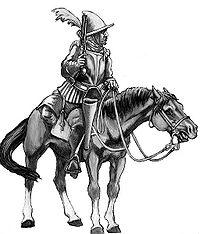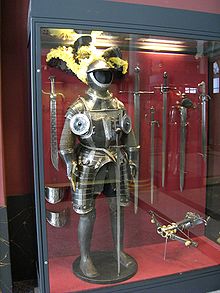Reiter





Reiter or Schwarze Reiter ("black riders", anglicized swart reiters) were a type of cavalry in 16th to 17th century Central Europe including Holy Roman Empire, Polish–Lithuanian Commonwealth, Tsardom of Russia, and others.[1]
Contemporary to the cuirassier and lancer cavalry, they used smaller horses, for which reason they were also known as Ringerpferde (corresponding to the French Argoulets). They were originally recruited in the North German Plain, west of the Oder river at the time of the Schmalkaldic War (1546–1547).
The Reiter raised
In general, commanders expected Reiters to be able to engage their opponents both with firearms and with swords. In the 16th century and up to about 1620, Reiters often formed up in deep blocks and used their firearms in a
The Reiters mostly consisted of
During the late 17th century, Reiters gradually merged into generic cavalry regiments and were no longer seen as a distinct class of horsemen.
The designation Reiter did however survive until 1918 as part of the title of one of the two Saxon heavy cavalry regiments: Konigliches Sachsen Garde Reiter Regiment.[3]
See also
- Dragoon—Another type of pistol-armed cavalry
References
- ^ Cherkas, B. "(РЕЙТАРИ)". Encyclopedia of History of Ukraine
- ^ Graf von Bismarck, Friedrich Wilhelm; Beamish, North Ludlow (1855). On the Uses and Application of Cavalry in War: From the Text of Bismark, with Practical Examples Selected from Antient and Modern History. T. & W. Boone. pp. 328–29.
- ISBN 0-85524-131-4.
